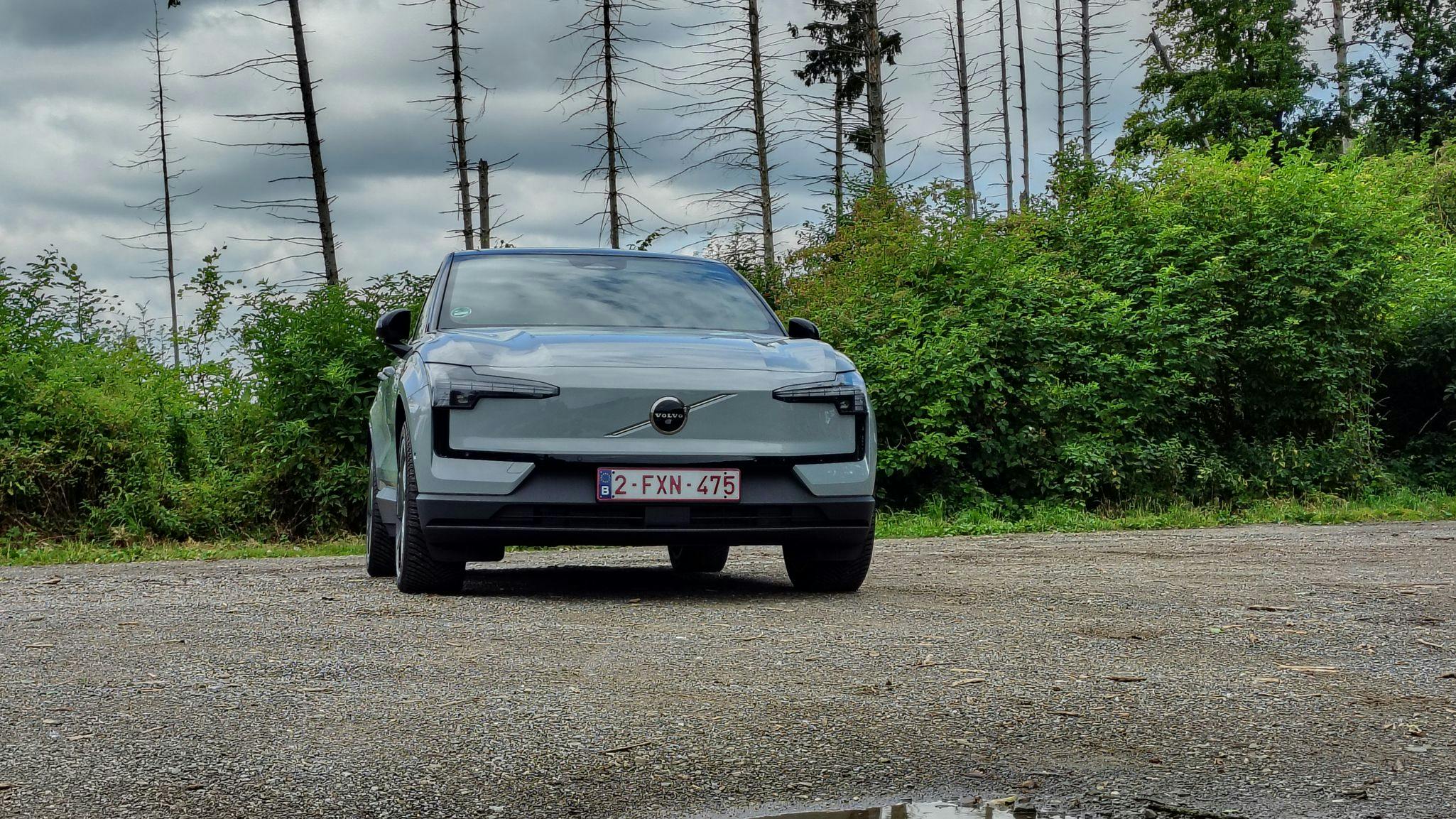
TAGTIK NEWS - TO THE POINT


The Volvo EX30 is a compact 100% electric SUV that will be very popular with Belgian corporate fleets by 2025. In fact, it is assembled in Ghent. To understand the craze, I was able to test its 200 kW (272 bhp) Extended Range version and take it to our German neighbours. So, is the success of the EX30 in the Kingdom of Philip I a patriotic and fiscal move, or a real crush?

In Belgium, the car industry now lives and breathes Volvo in Ghent. And the manufacturer's Belgian plant assembles the EX 30, the model we tested. However, the Swedish carmaker cannot hide its Chinese heritage. The fault lies in its overly tactile ergonomics, despite its pared-back Scandinavian design. Because let's face it: you'll often have to use the screen. There isn't even a handset or head-up display behind the steering wheel. So you'll have to get used to following the road with your left eye and the speed with your right. A rather dangerous exercise, at least if you want to protect your wallet from photo-radars. Because if you want to know how fast you're going, you can't rely on the speed warning system, which is too often off the mark.

Besides, there's safety and there's safety. When the vigilance system forgets, like the designers, that the eyes should be directed where the car should be going, aiming for the rope or the exit of the bend, it becomes irritating, moaning for nothing. He even complains when he realises that the eyes leave the road... to check the speed on the central screen. It's astonishing to see that, apart from the financial aspect of a single screen, Volvo is forgetting one of the fundamentals of road safety: looking towards where the car is going. And you haven't seen everything yet!

A friend of nature
The Volvo EX30 is instantly recognisable in traffic. Its headlights in the shape of Thor's hammers and its tailgate encircled by typical vertical lights are unmistakable. There was no need to write Volvo in big letters on the rear, we knew that. The 318-litre - 379-litre double-floor rear boot is complemented by a small frunk at the front. Despite its somewhat meagre volume, it's easy to stow a few items of luggage without the cable(s) getting in the way.

On board, the Scandinavian spirit is confirmed by the feeling of serenity and space, with clean, simple lines. The Göteborg-based manufacturer's teams have also paid particular attention to the quality of the sound system. In the Ultra finish, it's very good Harman Kardon with a sound bar in the windscreen. The name is even reflected on the glass. As for the rest, there's so little fuss in the cabin that there's only one vertical 12.3-inch screen at the front.

The front seats provide comfort, even if, at the end of the day, the body showed signs of fatigue. At the rear, the 4.33 m car falls victim to the geometric limits for the legs of tall people. There will never be leather upholstery. The materials used are eco-friendly, such as mixed wool, Pixel Knit (100% recycled PET polyester) or, like our model, Nordico biosourced vegan leatherette (recycled PET plastic, pine resin and recycled cork) combined with recycled denim. The plastics in the passenger compartment are also partly recycled from PVC waste. The result is a smooth, greyish finish that is pleasant to the touch. The denim fibre decorations are there, however, to give the whole thing a blue tinge. In any case, think about it when you sort your soda bottles. Maybe one day you'll be sitting on it at the wheel of a Volvo.

No fuss
There's no need to press any Start button to launch the Volvo. Just put your foot on the brake pedal. By creating a profile via one of the access cards, your smartphone or the thing that looks like a digital key, the car will directly adjust itself according to the driver's preferences for the seat, mirrors, steering wheel and infotainment. To start it up, all you have to do is use the switch on the right-hand side of the steering wheel. The same is then used to activate or deactivate the cruise control. Then, during regulated driving, you have to use the buttons on the steering wheel to change gear or opt for cruise control without lane keeping. Why not have everything centralised?

During our test drive on 19-inch all-season Michelin Cross Climate tyres, the rain came down on our way to Germany. When the downpour came down hard, severely limiting visibility, we had to go to the screen to switch on the fog lights. And not via a shortcut. No, via two touch-switches! And of course, during this time, you almost have to take your eyes off the road when it's not really the time... Moreover, even though the menus are clear and the main page gives access to a whole host of functions, the touch screen is used too often. Even to open the central glovebox or adjust the steering wheel and mirrors, for example. As we say in Belgium, in a bilingual expression that's a pleonasm: “trop is te veel” [too much is too much].

Efficient
The 200 kW (272 bhp) of the electric motor driving the rear wheels alone are energetic. The EX30 accelerates from 0 to 100 km/h in 5.2 seconds. In other words, it's a fast runner. And on the German Autobahn (motorway), when the tarmac is dry and the road clear, it quickly reaches speeds that are prohibited everywhere else. Its top speed? 180 km/h. Admittedly, this is where the chassis reaches its limit. So it's best to take your foot off the gas. And for range too. During the journey, which included Autobahn roads (often with roadworks or heavy traffic), country roads and city crossings around Cologne, the compact SUV consumed around 18 kWh/100 km. A small rule of three for the 65 kWh useful battery (69 kWh) means that the range can comfortably reach 350km.

Driving at a leisurely pace, fuel consumption is under 15 kWh/100 km for just over 400 km. At a maximum speed of 130 km/h on the motorway, energy consumption is around 21 kWh/100 km. At temperatures between 14°C and 20°C, this represents a range of around 280 km before the battery needs to be recharged at a fast-charging point. In Germany, the few stretches without limits saw fuel consumption climb to 27 kWh/100 km... When it comes to recharging, the EX30 is a little lazy in its communication with the socket. You sometimes have to wait a good minute before it activates. The maximum charging power is 158 kW. But our model has never exceeded 100 kW. But after a 30-minute wait, the battery still had at least 80% capacity.

The Volvo EX30 therefore has enough in reserve to envisage excursions or professional missions far from home. It can even offer some great moments with settings that favour comfort but don't shy away from dynamic driving. The One Pedal mode has an overrated name. It just avoids freewheeling when you lift off. It has an inertia effect similar to that of a combustion engine. But the brake often has to finish the job. Which is all very well for anticipatory driving. So I preferred to leave it on (one less thing to tap on the screen).

Let it lock
When you leave the car, let it lock. Or go to the driver's side and press the lock area on the handle. On the way back, there's no need to call the car with the remote control. It's not really a remote control, but a black transmitter unit. And yes, it's impossible to (un)lock it remotely. You have to approach the car for it to greet you with an animation of the LED headlights.

Let's go back to the Volvo for a moment and talk about Google Android Automotive. As with Polestar, I wasn't a big fan of this solution, which rejects the Android Auto pairing of the smartphone. Admittedly, this time I created a private account, as a Google Workspace pro account doesn't work without fiddling in the account admin to reduce the level of security. When programming the destination, the navigation directly suggested a recharging point added as a step. It was also possible to synchronise my Spotify account for music. The Harman Kardon playlist was remarkable. On the other hand, while the system can read SMS aloud and transcribe your reply, it cannot do so, unlike Android Auto, with WhatsApp messages. Because this very popular app is not available (yet).

The prices
The entry-level model has the same 200 kW engine, but with a more modest 49 kWh battery that is less versatile. In Belgium, Volvo is asking at least €38,180 for this solution in Essential trim. For the Extended Range variant, with the 69 kWh battery, the minimum charge is €45,850, because you have to opt for at least the Core trim level.

To buy the model tested with the Ultra finish, panoramic roof, premium sound system, 19-inch wheels, electric tailgate, lumbar support seats and all the packs, you need to spend €55,850! The catalogue also includes a 300 kW (428 bhp) twin-engined variant with all-wheel drive. I got to drive it for a while. It accelerates like mad (0 to 100 kph in 3.6 seconds). And it costs at least €55,130 in Plus trim and €58,530 in Ultra trim.

In France, the 200 kW Volvo EX30 Single Motor Extended Range starts at €43,300. With the trim we tested, that's at least €53,800! In Switzerland, the electric SUV with extended range starts at CHF 42,900. The well-equipped Ultra Extended Range version costs a minimum of CHF 48,800. In the Netherlands, the EX30 Single Motor Extended Range retails for at least €40,000, in Germany and Luxembourg for €45,000, and in the UK for £37,260.

(MH with Olivier Duquesne – Source : Volvo – Photos : © Olivier Duquesne)
LATEST NEWS

Jafar Panahi Wins New York Award and is Sentenced to Prison by Iran

Born on December 2: Peter Kingsbery, founder of Cock Robin with firebrand Ana LaCazio

Born on December 1: Julee Cruise, "Twin Peaks'" haunting voice

Born on December 1st: Alain Bashung, French rock poet who waited a long time for success

Born on November 30: Billy Idol, the (kind) rebel of Generation X

Born on November 28: Randy Newman tells stories and makes movies
Quick links